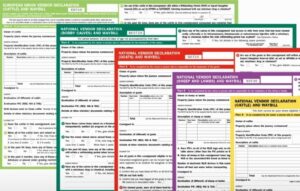By Joely Mitchell - story & photo courtesy FarmOnline here
Around 3000 farm audits are conducted every year to ensure producers are abiding by the requirements of the red meat industry's quality assurance schemes.

So how can you be sure that your farm ticks all of the relevant boxes?
Kathleen Allan is the communication and adoption manager of Integrity Systems, the company that manages Australia's three key on-farm assurance and traceability programs - Livestock Production Assurance (LPA), LPA National Vendor Declaration (LPA NVDs) and the National Livestock Identification System (NLIS).
Ms Allan said these programs were essential in ensuring the country's read meat industry was fully traceable and providing product that was safe to eat.
"The Australian red meat industry is a $28 billion industry that employs 40,000 people across 80,000 businesses and delivers product to 100 different global markets," she said.
"Transparent and rigorous record-keeping is essential in protecting our industry prosperity, market access and competitive advantage.
"Regardless of where you are in the supply chain, everybody has a role to play to ensure we stand by what we sell."
She said the LPA system provided on-farm assurance, covering farm management, food safety, animal welfare and biosecurity risks.
"It demonstrates the professionalism of our industry and is the tick of approval from producer to consumer," she said.
LPA NVDs are a crucial part of the records LPA-accredited producers must complete and keep to prove they have done their bit. She said the NLIS system enhanced the ability to monitor livestock and was all about identification and traceability.
"It tracks the locations of every animal throughout its life. It's mandatory for all producers but is underpinned by state and territory regulations."
She said these schemes were the only way traceability could be managed at a truly national level.
"For an industry that exports the majority of its product overseas, this is really important. Our international consumers don't care what state the product comes from, they want to know that it came from team Australia and that we have a national program in place."
Ms Allan said her biggest tip to producers filling out an LPA NVD was to be clear, correct and complete.
"This means when answering questions on the NVD, you check your records when it comes to the treatments your animals may have received. There';s a range of questions asking whether animals have been treated with hormone growth promotants (HGPs) or scabby mouth for sheep, or whether they have consumed any restricted animal materials."
For all of these questions, if in doubt, tick 'yes'. And make sure to always tick 'yes' or 'no', not both of them.
She said the LPA program was voluntary and there were 190,000 participants in it currently.
"Being part of it, producers need to do several things like keep their details up to date online, maintain their accreditation by doing online learning and assessments, and renewing it every three years," she said.
While there was work involved, being accredited gave you more options to market your livestock.
Seven requirements make up the LPA program. Producers who choose to participate in the LPA program commit to carrying out on-farm practices that feed into and support the integrity of the entire system. This integrity is verified when producers sign LPA NVDs for livestock moments.
The seven requirements of the LPA program include:
- Property risk assessment - identifying any possible risk on your property where livestock could come into contact with physical and/or chemical contaminants and develop strategies for how this risk will be controlled. This ensures the integrity of the meat produced, guaranteeing it's safe and of high quality.
- You are using safe and responsible animal treatments - as a producer it is your responsibility to ensure that animal treatments are administered in a safe and responsible manner that minimises the risk of chemical residues and physical hazards. Customers expect that livestock are treated responsibly and the meat producer is safe.
- Stock foods, fodder, crops, grain and pasture treatments - as a producer you must guarantee that animals are not exposed to foods containing chemical contamination or fed animal products.
- Preparation for dispatch of livestock - ensure livestock are fit for transport to minimise the risk of stress and contamination. This can include recording transport details and only selected animals that are fit to load, inspecting vehicles prior to transport and observe pre-consignment curfews.
- Livestock transactions and movements - record livestock movements to ensure treatments and exposure to food safety hazards are traceable,. Record all livestock purchases and sales and keep copies of all LPA NVDs.
- Biosecurity - have a Farm Biosecurity Plan to ensure livestock are, and remain, free from serious infectious diseases to allow you to maximise farm productivity and minimise animal discomfort, stock losses and medical costs.
- Animal welfare - ensure handling of livestock is consistent with the requirements in the Australian Animal Welfare Standards and Guidelines.
If you were chosen to be audited, "don't panic." If you're selected you will receive an LPA audit advice pack (which includes a checklist) and will then be contacted by an auditor to agree on a mutually-suitable time.
One the day, Ms Allan said the auditor would go through your records and take a tour of your facilities, looking at where you stored your checmicals, for example. If an issue was identified, there were three categories it could fall into - minor, major and critical.
She said critical issues could be something like your sheep found licking an old battery, and that could result in your accreditation being suspended until it was resolved.
But Ms Allan said it was important to remember that audits were about identifying areas for practical on-farm improvement.
For more information visit the Integrity Systems website.